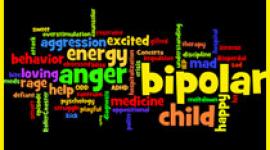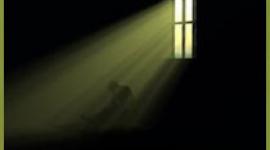Bipolar Disorder in Children and Adolescents: Patient Evaluations
Getting a clinical history is an important part of the bipolar diagnosis in children and adolescents.
 No laboratory study can be used to confirm the diagnosis of bipolar disorder. Therefore, gathering the history of present and past disturbances of mood, behavior, and thought is critical to properly diagnose a psychiatric condition such as bipolar disorder. Unlike other areas of medicine, in which the clinician often relies on laboratory or imaging studies to identify or characterize a disorder, mental health professionals rely almost exclusively on descriptive symptom clusters to diagnose mental disorders. As a consequence, the history is an essential part of the patient examination.
No laboratory study can be used to confirm the diagnosis of bipolar disorder. Therefore, gathering the history of present and past disturbances of mood, behavior, and thought is critical to properly diagnose a psychiatric condition such as bipolar disorder. Unlike other areas of medicine, in which the clinician often relies on laboratory or imaging studies to identify or characterize a disorder, mental health professionals rely almost exclusively on descriptive symptom clusters to diagnose mental disorders. As a consequence, the history is an essential part of the patient examination.
- The appropriate first step in evaluating a person for a psychiatric disorder is to ensure that no other medical condition is causing the mood or thought disturbance. Thus, the evaluation of the patient is best started by obtaining their oral history of current and past medical and behavioral symptoms and treatments. To further clarify the problem, gathering additional information from family and friends always is urged for a person experiencing an altered mood or behavioral state.
- After interviewing the patient, performing a physical examination, and gathering more information from family, friends, and perhaps other physicians to whom the patient is known, the problem may be classified as being primarily caused by a physical health problem or by a mental health problem.
- While obtaining the history, the physician must explore the possibilities that substance abuse or dependence, trauma to the brain in the present or past, and/or seizure disorders may be contributing to or causing the current symptoms of illness.
- Similarly, central nervous system (CNS) insults, such as encephalopathy or medication-induced mood changes (ie, steroid-induced mania), must be considered. Delirium is one of the most important medical conditions to exclude early in persons presenting with altered mental states or acute disturbances of mood and conduct.
- Perhaps more relevant to youth is the evaluation of substance abuse patterns because acute drug intoxication states may mimic bipolar disorder.
- If the physical examination does not reveal a medical condition contributing to the patient's mental state, a thorough mental health evaluation is appropriate. Through observation and interviewing, mental health professionals may learn of mood, behavioral, cognitive, or judgment and reasoning abnormalities.
- The mental status examination (MSE) is the essential component of a mental health evaluation. This examination goes beyond the mini-mental status examination (eg, Folstein Mini-Mental State Examination to screen for dementia) often used in emergency departments. Rather, the MSE assesses general appearance and demeanor, speech, movement, and interpersonal relatedness of the patient with the examiner and others.
- Mood and cognitive abilities (eg, orientation to circumstance; attentiveness; immediate-, short-, and long-term modes of memory) are assessed in the MSE.
- Some of the most important components of the MSE are those addressing issues of safety of individuals and members of a community. Thus, suicidal and homicidal issues are explored.
- Similarly, screens for the more subtle forms of psychosis, such as paranoid or delusional states, in addition to screens for overt psychosis, such as observing the patient responding to unseen others or other non-reality-based internal stimuli, are explored.
- Lastly, insight into the patient's mental and physical states, the current circumstances of medical or mental health care, and the patient's ability to use age-appropriate judgments are assessed and integrated into the evaluation of the global mental state of the patient at that moment.
- Because bipolar disorder may cause a transient but marked impairment of judgment, insight, and recall, multiple sources of information are crucial to understand a particular patient. Thus, other family members, friends, teachers, caregivers, or other physicians or mental health care workers may be interviewed to clarify the full clinical picture.
- Nonetheless, the patient's subjective experience is essential in the evaluation and treatment processes, and the establishment of a therapeutic alliance and trust early in the assessment is vital to obtaining an accurate and useful history from the patient.
- Knowledge of the family's psychiatric history is another essential part of the patient's history because bipolar disorder has genetic transmission and familial patterns. A genogram may be developed to further describe a particular patient's risk of bipolar disorder based on familial and genetic attributes within the family system.
Physical:
- The physical examination must include a general neurologic examination, including examination of cranial nerves, muscular bulk, and tone and deep tendon reflexes.
- Cardiovascular, pulmonary, and abdominal examinations are also essential because abnormal pulmonary functioning or poor vascular perfusion of the brain may cause abnormal mood, behavior, or cognition.
- If these examinations do not reveal a medical condition contributory to the current mental state, a mental health evaluation should be sought
Causes:
- Genetic and familial factors have profound influence in the propagation of bipolar disorder.
- Chang and colleagues (2000) report that children who have at least one biological parent with bipolar I or bipolar II disorder have increased psychopathology. Specifically, 28% of the children studied had attention deficit/hyperactivity disorder (ADHD); this figure is far above the general population prevalence of 3-5% in school-aged children. Also, 15% of the children had a bipolar disorder or cyclothymia. Approximately 90% of children who have bipolar disorders had comorbid ADHD. Moreover, in this study, both bipolar disorder and ADHD are more likely to be diagnosed in males than in females.
- Early age of onset of bipolar disorder is predictive of a higher rate of mood disorder among first-degree relatives of the proband (Faraone, 1997). Also, adolescents who have onset of true mania with childhood-associated psychotic symptoms, such as aggression, mood shifts, or attention difficulties, have a greater genetic risk (family loading) for bipolar I disorder than adolescents with more adult-related psychotic symptoms, such as grandiosity. Other unique features of youths with early-onset bipolar disorder include (1) poor or ineffective response to lithium therapy (administered as Eskalith) and (2) an associated increased risk of alcohol-related disorders in the family members of the probands.
- Twin studies of bipolar disorder show a 14% concordance rate in dizygotic twins and a 65% concordance rate (ranging from 33-90%) in monozygotic twins. The risk for the offspring of a couple in which one parent has bipolar disorder is estimated to be approximately 30-35%; for an offspring of a couple in which both parents have bipolar disorder, the risk is approximately 70-75%.
- Faraone further delineated the differences among children with mania, adolescents with childhood-onset mania, and adolescents with adolescence-onset mania. Important findings in this work include the following:
- Socioeconomic status (SES) was statistically lower in families of children with mania and adolescents with childhood-onset mania.
- Increased energy was twice as common in childhood mania, euphoria was most common in adolescents with childhood-onset mania, and irritability was least common in adolescents with adolescent-onset mania.
- Adolescents with adolescent-onset mania statistically had more abuse of psychoactive drugs and exhibited more impaired parent-child relationships than individuals in the other 2 groups with mania.
- ADHD was more common in children and adolescents with childhood-onset mania than in patients with adolescent-onset mania, leading the authors to theorize that ADHD may be a marker for juvenile-onset mania.
- This and other studies (Strober, 1998) suggest that a subtype of bipolar disorder may exist that has a high familial transmission rate and presents with childhood-onset of mania symptoms suggestive of ADHD.
- Faraone proposes that early-onset mania may be the same as the comorbid state of ADHD and bipolar disorder, which has a very high rate of familial transmission. The question exists regarding whether youths who later are given the diagnosis of bipolar disorder may have a prodromal phase in early life that appears to be ADHD or another behavioral disturbance or whether many simply have bipolar disorder and comorbid ADHD.
- Cognitive and neurodevelopmental factors also seem to be involved in the development of bipolar disorder.
- A case-cohort study of adolescents with affective disorders reveals that neurodevelopmental delays are overrepresented in early-onset bipolar disorders (Sigurdsson, 1999). These delays occur in language, social, and motor development approximately 10-18 years before affective symptoms appear.
- Adolescents who had early developmental antecedents were noted to be at high risk of developing psychotic symptoms. In addition, intelligence quotient (IQ) scores were significantly lower in patients with early-onset bipolar disorder (mean full scale IQ 88.8) than in patients with unipolar depression (mean full scale IQ 105.8).
- Lastly, a statistically significant difference in the mean verbal IQ and mean performance IQ was found only in patients with bipolar disorder.
- Overall, patients with more severe bipolar disorder had an average lower IQ than those with mild-to-moderate forms of the disorder.
- Finally, environmental factors also contribute to the development of bipolar disorder. These may be behavioral, educational, family-related, toxic, or substance abuse-induced.
- Diagnoses of mental health problems increase the risk of suicide in adolescents compared to their healthy peers.
- Adolescent patients in whom bipolar disorder is diagnosed are at higher risk of suicide than adolescents with other behavioral illnesses. Family conflict and substance abuse exponentially increase this risk.
- Another risk factor for suicide in youths is legal problems. One study found 24% of adolescents who attempted suicide had faced legal charges or consequences within the past 12 months.
- Incarcerated youths also have an inordinately high number of mental illnesses; some are facing legal consequences as a direct result of behaviors that arise from uncontrolled or untreated mental disorders. The manic state of bipolar disorder can be particularly problematic for adolescents because the disinhibited risk-taking behaviors driven by the disorder can easily lead to legal problems, such as public disorderly conduct, theft, drug seeking or use, and agitated and irritable mood that results in verbal and physical altercations.
Biological and biochemical factors
- Sleep disturbances often aid in defining abnormal mood states of bipolar disorder in either the manic or depressed state.
- A profoundly decreased need for sleep in the absence of a sense of fatigue is a strong indicator of a manic state.
- An uncomfortable reduction of sleep is a pattern of an atypical depression episode in which more sleep is wanted but cannot be achieved. Conversely, a typical depression episode may be indicated by hypersomnolence, an excessive but irresistible need for sleep.
- The biology that drives these anomalies of sleep in mood disturbances is not fully appreciated. Some suggest that neurochemical and neurobiological shifts cause these episodic sleep disturbances in conjunction with other shifts that occur in the evolution of manic or depressed states.
- Bipolar disorder and other mood disorders are increasingly better understood in the context of neurochemical imbalances within the brain.
- Although the circuits of the brain that modulate mood, cognition, and behavior are not well defined, the database of neuroimaging studies that facilitate increased appreciation of possible modulating pathways that connect several brain regions to work in unison to regulate thoughts, feelings, and behaviors is constantly growing.
- An association of neurotransmitters acts upon various brain regions and circuits to modify and regulate brain activity. Table 1 reflects the putative roles of some CNS neurotransmitters within brain circuits.
Table 1. Neurotransmitters of the CNS
Neurotransmitter Activity Modified Serotonin Mood (happy, sad, euthymic) Dopamine Pleasure (hedonia, anhedonia) Norepinephrine Alertness, energy level (lethargy, frenzy, vigilance) Acetylcholine Memory and cognition GABA Inhibition of CNS neurons Glutamate Excitation of CNS neurons - One proposal suggests that several neurotransmitters acting in unison but with dynamic balance act as modulators of mood states. In particular, serotonin, dopamine, and norepinephrine appear to modify mood, cognition, and sense of pleasure or displeasure.
- Pharmacotherapy for the regulation of bipolar mood swings is thought to be based on the use of medications that facilitate the regulation of these and perhaps other neurochemicals to restore a normal mood and cognition state.
Sources:
- AACAP Official Action. Practice parameters for the assessment and treatment of children and adolescents with bipolar disorder. J Am Acad Child Adolesc Psychiatry. Jan 1997;36(1):138-57.
- Biederman J, Faraone S, Milberger S, et al. A prospective 4-year follow-up study of attention-deficit hyperactivity and related disorders. Arch Gen Psychiatry. May 1996;53(5):437-46.
- Chang KD, Steiner H, Ketter TA. Psychiatric phenomenology of child and adolescent bipolar offspring. J Am Acad Child Adolesc Psychiatry. Apr 2000;39(4):453-60.
- Faraone SV, Biederman J, Wozniak J, et al. Is comorbidity with ADHD a marker for juvenile-onset mania?. J Am Acad Child Adolesc Psychiatry. Aug 1997;36(8):1046-55.
- Sigurdsson E, Fombonne E, Sayal K, Checkley S. Neurodevelopmental antecedents of early-onset bipolar affective disorder. Br J Psychiatry. Feb 1999;174:121-7.
next: Bipolar Symptoms in Children Mimic Other Psychiatric Disorders
~ bipolar disorder library
~ all bipolar disorder articles
APA Reference
Tracy, N.
(2008, October 16). Bipolar Disorder in Children and Adolescents: Patient Evaluations, HealthyPlace. Retrieved
on 2026, January 22 from https://www.healthyplace.com/bipolar-disorder/articles/bipolar-disorder-in-children-and-adolescents-patient-evaluations



